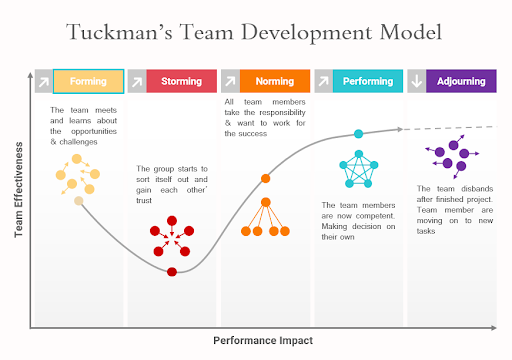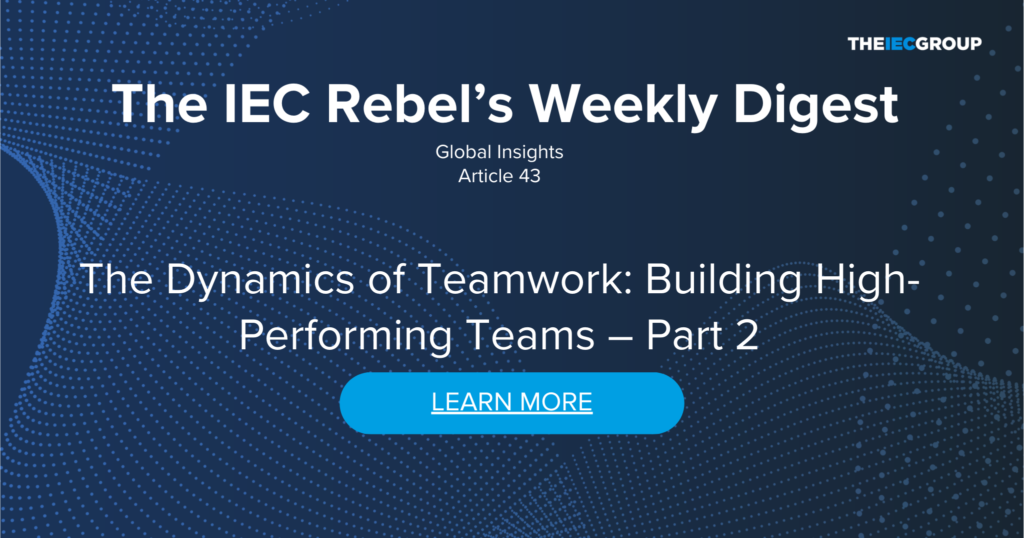Unlocking the Stages of Team Growth: A Path to Peak Performance
 Building a high-performing team is a journey, not a destination. As organizations rely more on collaboration to drive success, understanding team dynamics is essential. In this article, we explore the path to creating a high-performing team by diving into Bruce Tuckman’s Team Development Model, which outlines the stages teams typically go through: Forming, Storming, Norming, and Performing.
Building a high-performing team is a journey, not a destination. As organizations rely more on collaboration to drive success, understanding team dynamics is essential. In this article, we explore the path to creating a high-performing team by diving into Bruce Tuckman’s Team Development Model, which outlines the stages teams typically go through: Forming, Storming, Norming, and Performing.
Each stage presents unique challenges and opportunities, and navigating them effectively can unlock the full potential of your team.
We will break down the dynamics at each stage, provide practical strategies to move through them, and offer insights on how leaders can guide their teams towards achieving greater cohesion, trust, and efficiency. From managing conflict in the Storming phase to fostering self-sufficiency in the Performing stage, this article will help you understand how to develop a team that consistently delivers exceptional results.
Join us as we explore how to build, nurture, and lead teams that not only meet but exceed expectations.
Introduction
In the previous article, we explored the undeniable importance of teamwork in driving organizational success. Now, we shift our focus to the dynamics that fuel high-performing teams and the path to achieving such performance. One of the most widely recognized models for understanding team development is Bruce Tuckman’s Team Development Model, which outlines the stages teams go through as they evolve. In this article, we will examine the dynamics within these stages and provide actionable insights into fostering a high-performing team.
Understanding Team Dynamics Through Tuckman’s Model
Tuckman’s model, first introduced in 1965, presents four essential stages that teams typically progress through: Forming, Storming, Norming, and Performing. He later added a fifth stage, Adjourning, to describe teams that are disbanding. Each of these stages involves different dynamics and challenges, and understanding them is critical for steering teams towards high performance.

- Forming: The Beginning
In the Forming stage, team members are coming together for the first time. They are getting to know each other and are often polite, avoiding conflict. There is excitement, but also uncertainty, as roles and responsibilities are not yet clear. The main focus is on orienting and gathering information.
Team Dynamics in Forming:
- High dependence on the leader for direction.
- Roles and expectations are unclear.
- Little conflict, as members are still figuring out boundaries.
Key Actions for Leaders:
- Set clear goals, roles, and expectations early on.
- Encourage open communication and build trust through icebreakers and team-building activities.
- Storming: The Challenge Phase
As teams move into Storming, conflicts arise as individuals assert themselves and differences in opinions, working styles, and personalities emerge. Power struggles may occur, and this is often the most challenging phase. If not managed well, teams may regress, but if navigated correctly, it can be an opportunity for growth.
Team Dynamics in Storming:
- Tension and disagreements over roles and procedures.
- Resistance to authority or established norms.
- Increased competition between team members.
Key Actions for Leaders:
- Address conflicts head-on and mediate where necessary.
- Promote a culture of respectful dialogue and constructive feedback.
- Reinforce the team’s vision and purpose to align members’ efforts.
- Norming: Establishing Cohesion
In the Norming stage, team members begin to resolve their differences and develop a stronger sense of cohesion. Roles become clearer, and there’s a growing acceptance of each other’s strengths and weaknesses. Collaboration improves, and team members start to work more effectively together.
Team Dynamics in Norming:
- Greater agreement on roles, responsibilities, and goals.
- Enhanced collaboration and mutual support.
- A stronger sense of team identity and belonging.
Key Actions for Leaders:
- Continue to provide support and reinforce positive behaviors.
- Encourage deeper collaboration and recognize achievements.
- Facilitate opportunities for professional and team development.
- Performing: Reaching High Performance
Once a team reaches the Performing stage, they operate as a cohesive unit with high levels of trust, collaboration, and efficiency. They are fully focused on achieving their goals and can handle decision-making and conflict internally, with minimal direction from the leader.
Team Dynamics in Performing:
- High levels of trust, communication, and interdependence.
- Teams are self-sufficient, productive, and solutions-oriented.
- Greater innovation and problem-solving capacity.
Key Actions for Leaders:
- Delegate more responsibility and empower the team to make decisions.
- Encourage continuous improvement and celebrate milestones.
- Stay available as a mentor while fostering autonomy.
- Adjourning: Closure and Reflection
When teams disband after completing their objectives, they enter the Adjourning stage. This can involve reflection on what was learned and acknowledgment of individual and group contributions.
Team Dynamics in Adjourning:
- Mixed emotions as the team dissolves; pride, sadness, or relief.
- Reflection on accomplishments and lessons learned.
- Planning for future endeavors.
Key Actions for Leaders:
- Recognize and celebrate the team’s success.
- Conduct post-mortem reviews to capture learnings.
- Help team members transition to new projects or roles.
Path to High-Performing Teams
Achieving a high-performing team is a process, not an event. As teams move through Tuckman’s stages, they must also develop core attributes that define high performance:
- Psychological Safety: Encourage an environment where members feel safe to share ideas, take risks, and make mistakes without fear of judgment.
- Clear Goals and Accountability: Ensure that the team understands its purpose and how individual contributions align with larger goals.
- Diversity and Inclusion: Leverage the diverse perspectives and experiences within the team to foster creativity and innovation.
- Open Communication: Promote transparency and regular feedback, ensuring that conflicts are addressed promptly and constructively.
Conclusion
The journey to becoming a high-performing team is one of growth, conflict resolution, and adaptation. Understanding the stages of team development through Tuckman’s model provides a roadmap for leaders and team members alike. By nurturing the dynamics at each stage and promoting a culture of trust and collaboration, teams can overcome challenges and reach their full potential.
In the next articles, we will explore strategies to foster psychological safety within teams, a critical component for unlocking high performance, and how to accelerate the path to a high performing team. Stay tuned!
Go To’s: After reading the article on becoming a high-performing team, here are some key actionable steps:
- Assess Your Team’s Current Stage (Forming, Storming, Norming, Performing):
Evaluate where your team stands within Tuckman’s stages. While measuring exact timeframes for each stage may be challenging, especially with temporary or virtual teams, reflecting on how long it takes for the team to transition through each phase can offer valuable insights. Gaining a sense of which stage your team is in and how long it has taken to progress helps identify areas for improvement. - Analyze Team Development Patterns:
Track and reflect on the time spent in each stage for both current and past teams. Identify trends or recurring obstacles that cause delays in progression. Even though precise measurements are difficult, understanding these patterns provides a foundation for accelerating future team development. - Apply Stage-Specific Strategies:
Tailor your leadership and team-building efforts to the specific stage the team is in. During Forming, focus on clear goals and introductions, while during Storming, address conflicts openly. Norming requires reinforcement of positive behaviors, while Performing calls for delegating responsibility. - Adapt to Temporary and Virtual Teams:
For temporary or virtual teams, where the stages might unfold differently, remain flexible. Virtual environments may require extra effort in fostering communication and trust, and timelines may be compressed or extended. Recognize the unique dynamics of these teams and adjust your strategies accordingly. - Foster Continuous Improvement:
Regularly review team progress and dynamics, adjusting strategies as needed to keep the team moving toward high performance. Understanding how each stage evolves over time will be key when we later delve into continuous improvement practices for high-performing teams.
Introducing the IEC Knowledge Network Free Membership – Your Gateway to Seamless Access!
We are thrilled to present a new service that goes beyond the ordinary download experience. In addition to offering you the ability to download the things you love, we are delighted to introduce the IEC Knowledge Network Free Membership.
The Free Membership option grants you access to our library of articles and videos, without the need for tedious registrations for each piece of content.
The publication serves as a trusted resource to support executives in their pursuit of sustainable and successful global expansion. In addition the IEC Practitioners are available to discuss your specific challenge in more detail and to give you clear advise..
Take advantage of this valuable resource to accelerate your global expansion journey


